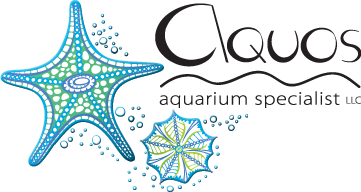Because Stuff Happens
Welcome to our references section. We’ve tried our best to gather information that will help our customers answer some basic aquarium-keeping questions. If you need further assistance or don’t see the information you need, please feel free to e-mail us and we’ll be happy to help.
Skip to the section you need
Stop Overfeeding The Fish!
This is one of the most common problems we encounter. A large number of aquarium problems can be traced back to overfeeding. If you notice a large amount of fish food collecting on the bottom during feedings, you’ll want to scale back how much food you’re using. This is a great lesson in less is more. You can always feed them again later, but it’s hard to take food out of the tank. Read up on the eating habits of the fish in your tank and adjust your feedings accordingly.
Maintenance & Equipment
Aquariums can have a lot of equipment in a small amount of space. It is important to regularly check the tank lighting, plumbing fixtures, stand, and power supply to ensure things are running smoothly. Make sure power strips are able to handle the electrical load. Check for salt creep, a build up of salt outside of the tank. This is especially important around electrical outlets and power strips. Aquariums that are properly set up and ventilated should not have a problem with salt creep. Old lighting can also cause potential problems, both in efficiency and in aquarium health. Make a habit of regularly checking under, behind, and around your fish tank. If you see anything that concerns you, give Aquos a call and we’ll be happy to help.
Tank Sizes
Here are the common standard tank sizes (Length x Depth x Height) in inches. These dimensions are approximate and may differ slightly depending on the manufacturer.
| Tank Size | L x D x H | Tank Size | L x D x H |
|---|---|---|---|
| 20 Long | 30 x 12 x 13 | 29 Gal. | 30 x 12 x 17 |
| 33 Gal. | 48 x 12 x 13 | 38 Tall | 36 x 12 x 17 |
| 40 Long | 36 x 18 x 13 | 45 Long | 48 x 12 x 17 |
| 55 Gal. | 48 x 12 x 21 | 65 Gal. | 36 x 18 x 25 |
| 75 Gal. | 48 x 18 x 21 | 90 Gal. | 48 x 18 x 25 |
| 120 Gal. | 48 x 24 x 25 | 125 Gal. | 60 x 18 x 25 |
| 180 Gal. | 72 x 24 x 25 |
Glass vs. Acrylic Tanks
There are pros and cons to acrylic and glass aquariums. Here at Aquos we prefer glass aquariums whenever possible. Their proven durability over the years provides great value for the customer.
Glass Pros
Glass is a highly durable substance making it very easy to clean, especially for marine aquariums where coraline algae needs to be scraped off regularly. Glass is less expensive than acrylic. The use of silicone seams allow glass tanks to withstand minimal structural torque, although any torque is never a good idea.
Glass Cons
The high durability of glass also means it is not possible to repair scratches, so proper care must be taken to avoid them in the first place. Optically, glass is not as clear as acrylic unless low-E glass is used — dramatically increasing the expense. Clarity is usually not a problem for most applications because the glass is simply not thick enough to make a difference. However, glass tanks have visible seams on the corners. Structurally, glass has a size limit so it cannot be safely used for really large aquariums.
Acrylic Pros
Acrylic is highly versatile and strong, making it ideal for large or oddly shaped aquariums. Optically, acrylic is superior to glass, being near perfectly clear and without tint of any kind. Acrylic tanks are seamless at the corners having no panel joints, so there is no silicone seal to view or worry about during cleaning. It is posible to repair scratches with the right buffing materials.
Acrylic Cons
The high versatility of acrylic also means it is a comparatively soft material. This leaves it highly prone to scratches, making cleaning a tedious exercise. The process of buffing out scratches inside the tank can leave a light hazing effect, compromising optical clarity. Acrylic panel seams are ridged, leaving them highly susceptible to damage caused by support structure torque.
Water Parameters
These measurements are for normal reef tank water parameters. Certain types of aquariums may require slightly different levels. If you aren’t sure, just shoot us an e-mail. We will happily give you our thoughts on the matter.
| Parameter | Range |
|---|---|
| Salinity or Specific Gravity | 32 – 35 ppm or 1.023 – 1.026 |
| Temperature | 76 – 79 F |
| Calcium (CA) | 380 – 450 ppm |
| Carbonate Hardness (KH) | 8 – 10 dKH |
| pH | 8.1 – 8.3 |
| Magnesium (MG) | 1200 – 1400 ppm |
| Nitrate (NO3) | 5-10 |
| Nitrite (NO2) | 0 |
| Ammonia (NH3) | 0 |
| Phosphate (PO4) | < .25 |
Common Problems
The following are common problems encountered by hobbyists and the basics on how to fix them. A quick note here, we are assuming the use of nothing but reverse osmosis deionized (RODI) filtered water. If you are using tap water, you are working against yourself.
Nuisance Algae
Green hair algae — Commonly forms in 1- to 3-inch long turf style clumps.
This stuff really goes crazy when nitrates (NO3) and phosphates (PO4) have accumulated in the water. Remove large clumps while performing water changes. Reduce feedings as much as possible without starving your fish. Make sure your water circulation is sufficient to keep the rocks free of debris. Aggressive protein skimming may help, go for tea colored liquid instead of the dark coffee color. Watch for a salinity drop if you are emptying the skimmer collection cup frequently. The use of bacterial supplements such as Prodibio “Bio-Digest” may prove useful. In extreme circumstances a 48 – 72 hour, bi-weekly blackout may be used. Kill the lights and close the shades, this may just give you a leg up. Watch your corals closely for signs of stress, use your best judgement here.
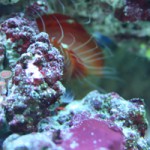
Example of Cyanobacteria
Cyanobacteria — Commonly forms burgundy, dark green, or dark blue mats on rocks and sand.
This bacteria is literally in every body of water in the world, so don’t stress out just because you see a little bit. However, if it starts to become unsightly or begins to cover and damage corals, it is time to take action! Check your phosphate level and use a phosphate binding media if needed. Next, check your fish food for high levels of Ash, a.k.a. phosphate. [Cheap food usually costs you more later, in both your time and your money. Go ahead get the good stuff!] Siphon out larger clumps and brush off rocks while doing a water change. More water flow may be needed to reduce the presence of “dead spots”, or areas of very low water movement where debris accumulates. Check the age and color specification of your lighting. As bulbs age their color spectrum shifts and may be working against you. Bulbs designated for use in freshwater aquariums can also cause trouble.
Bubble algae — Commonly forms in groups of emerald green bulbs that look like marbles or beads.
Check your nitrate levels. If they are high, work on getting them down. If the algae becomes unsightly, go get a small diameter hose. With one hand hold the end of the hose between your thumb and middle finger, keeping your pointer finger free. Start the siphon and use your pointer finger scratch off the bubbles so they are pulled into the siphon and out of the tank. Emerald crabs can be used with some success to control future growth, but they will not eliminate the problem.
Diatom algae — Commonly forms slimy strands that are brown in color with gas bubbles trapped within the filaments.
This stuff will make you appreciate properly filtered water! Diatom explodes in the presence of silicates, commonly found in tap water. Use good water and fan off rocks and sand frequently. A coarse filter media in a power filter or sump system helps clear the water. Change the media frequently. Do a couple of good water changes using pure RODI water and it should start to go away on its own. On a positive note, there are lots of things that feast on diatom. This might be a good time to add that new tang or blenny you’ve been wanting! This is also a great time to add snails and crabs, which usually come out of your local fish store somewhat malnourished.
Common Fish Ailments and Parasites
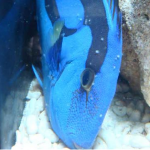
Example of Marine Ick
Marine Ick (Cryptocaryon irritans) — This is a parasite that most noticeably appears as tiny white dots on the fish’s body and fins.
Ick normally infects the gills before it is actually visible. Symptoms will appear as heavy breathing, erratic behavior and rubbing on rocks and sand. Heavily infected fish will present white filmy slime on the body as a result of the irritation caused by the parasite. This is a very common parasite and is normally lethal in all but the healthiest fish if left untreated. In reef tanks and aquariums with invertebrates the only medication that can be used is Ruby’s Reef “Kick-Ick.” Success with this treatment is hit or miss. Early diagnosis and action help. Removal of the infected fish to quarantine is recommended, where copper medication can be used, usually with great success. This Reefkeeping article has much more detailed information.
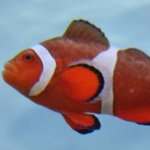
Example of Marine Velvet
Marine Velvet (Amyloodinium ocellatum) — Presents similar symptoms to Marine Ick without the tiny white spots.
Please note Velvet can occur in conjunction with Marine Ick. Fish will appear stressed and show erratic behavior, rubbing on rocks and sand. Normally a white slimy film appears all over the fish. Immediate action is required if you suspect Velvet. A combination of Ruby’s Reef “Kick-Ick and Rally” may be used if caught early. This treatment has shown limited success. Early diagnosis and action help. Removal of the fish to quarantine is recommended, where copper medication can be successful if started soon enough. We have seen Velvet wipe out entire tanks in 5-10 days. Make an effort to quarantine all new fish, if there is ever a reason to do so, this is it! This article by Reefkeeping has much more detailed information.
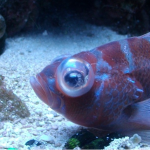
Example of Pop-eye
Pop-eye — Presents as first a clouding, followed by a bulging in one or both eyes.
Usually Pop-eye is the result of an injury with secondary bacterial infection. Fish fighting with other fish, or a startled fish scraping against a rock or decoration can cause an open wound. If the conditions in the tank are substandard, it provides an ideal opportunity for a bacterial infection to set in. Excellent water quality is the best way to avoid Pop-eye, and is the best cure. In some instances an anti-bacterial medication should be used in quarantine. Again, prevention is the best bet here. Keep your tanks clean and you will most likely never have to deal with this.
Flukes & Worms — These are both parasites.
Flukes normally appear as white or light tan threads hanging off of the body and gills. The gills may become inflamed and protrude beyond the protective gill cover. Fish may appear stressed with heavy breathing and show erratic behavior, rubbing on rocks and sand. Worms usually first appear as lumps underneath the skin of the fish, where the stomach and intestines are. The fish may start to appear lumpy and bloated. Advanced infections will present with worms being expelled with waste. Worms appear as white and string-like. In both cases, quarantine and the use of anti-parasitic medication are the best course of action.
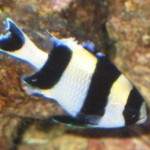
Example of Fungus
Fungus — Appears as white cottony tufts on a fish’s fins and body.
Normally a healthy fish will be able to eliminate fungus without assistance. A proper diet and excellent water quality will aid their healing. In some cases, a round of quarantine may be needed with some anti-bacterial medication. Fungus in not contagious, so there is no need to treat other fish that are not showing symptoms.
